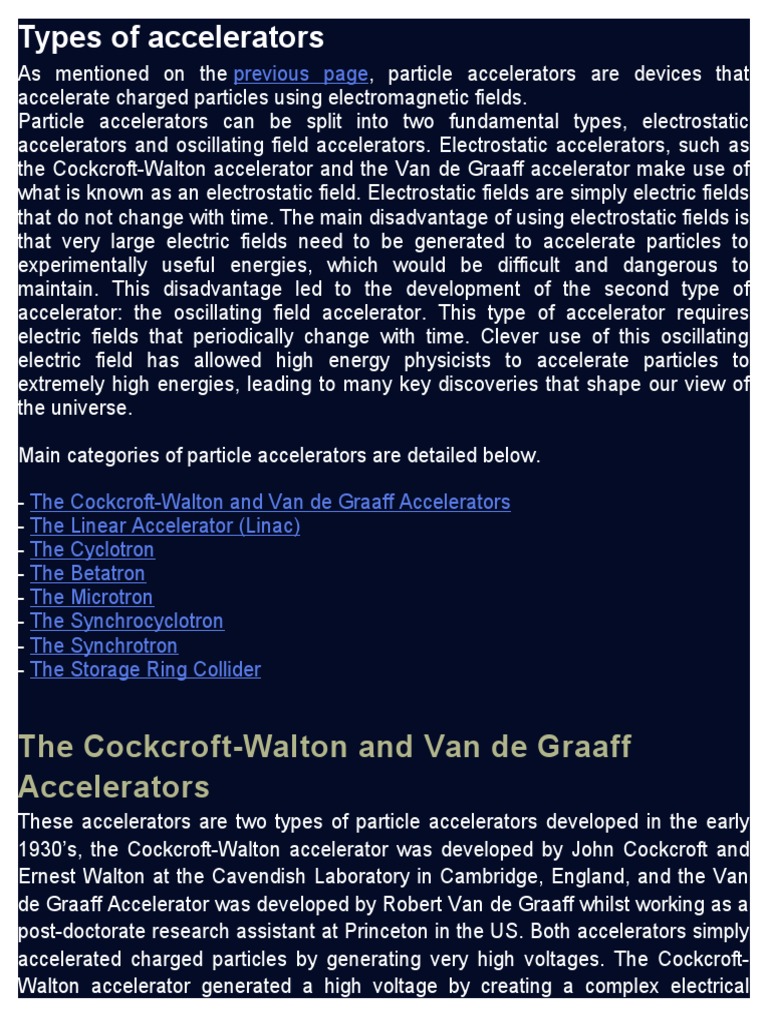Particle accelerators, sophisticated instruments designed to propel charged particles to high velocities, serve a pivotal role in the realm of modern physics. Their primary function is to collide particles at incredible speeds, thereby facilitating the exploration of fundamental forces and constituents of matter. This thorough examination will delineate the various types of particles that are commonly utilized within these accelerative environments, elucidating their unique properties, and the subsequent applications and discoveries stemming from such collisions.
At the core of any particle accelerator’s operation is the choice of the particle type. Broadly, particles can be categorized into charged and neutral varieties, with the former being the most prevalent in accelerator experiments due to their ease of manipulation and control. Charged particles, such as electrons, protons, and various ions, have been employed extensively for their versatility and ability to interact effectively with other particles.
First and foremost, electrons are among the most significant particles used in accelerators. Given their relatively small mass and elementary charge, electrons are capable of attaining high velocities and low energies. Consequently, electron accelerators, or synchrotrons, are utilized for a myriad of applications, including synchrotron radiation generation, which is a crucial method for studying molecular structures via X-ray crystallography. Furthermore, colliders like the Large Electron-Positron Collider (LEP) have leveraged electron collisions to provide insights into the Standard Model of particle physics, especially concerning the properties of the Z boson.
In addition to electrons, protons represent another fundamental type of particle utilized in accelerators. Proton accelerators, such as the Large Hadron Collider (LHC), enable high-energy collisions between protons to probe the intricacies of the strong force, which is responsible for binding quarks within protons and neutrons. The discovery of the Higgs boson in 2012 at the LHC signified a monumental achievement in particle physics, highlighting the role of protons in advancing our understanding of the universe’s architecture.
In the operational spectrum of particle accelerators, ions play a crucial role. Charged atomic nuclei, ranging from simple helium nuclei to heavier ions such as lead, are accelerated to achieve significant energy levels. The collisions of these ions, as conducted in heavy-ion accelerators like the RHIC (Relativistic Heavy Ion Collider), replicate conditions similar to those postulated to exist just microseconds after the Big Bang. This experimentation facilitates the study of quark-gluon plasma—a state of matter theorized to exist at extraordinarily high temperatures and densities, providing fundamental insights into the primordial conditions of our universe.
Furthermore, the usage of positrons—anti-particles of electrons—has garnered attention in recent years. By colliding electrons and positrons, scientists can achieve near-complete energy conversion into mass, generating exotic particles and providing evidence for symmetry principles in particle physics. Such experiments have underscored the potential to produce heavier particles, advancing theoretical frameworks concerning matter-antimatter asymmetry.
Another noteworthy particle type is muons. These heavier relatives of electrons offer unique advantages in experimental physics due to their longer lifespan and higher mass, which permits probing phenomena in greater depth. Muon accelerators have been proposed as potential successors to electron and proton colliders, potentially enabling studies of beyond-the-Standard-Model physics through more nuanced interaction channels.
Aside from fundamental particles, composite particles also play a vital role in accelerator physics. This category encompasses mesons and baryons, which are formed by quarks bound together by the strong force. Accelerators designed to collide protons can produce mesons as intermediate states; tracking these particles can yield critical information about the strong interaction dynamics and facilitate enhancements in nucleon-nucleon collision models.
Additionally, neutrinos represent a notable subset of particles studied in accelerators, albeit with unique challenges. These elusive, neutral partners to electrons and other charged particles interact via the weak force, making them challenging to detect. Experiments such as those conducted at Fermilab and CERN utilize the byproducts of proton collisions to generate high fluxes of neutrinos, opening avenues to study their elusive properties and mass behavior while advancing the quest for understanding flavors and lepton interactions.
Lastly, the advent of novel accelerator techniques has opened avenues for the utilization of exotic particles such as antiprotons and hyperons. Antiprotons, formed via the annihilation of protons and antiprotons, present profound implications for understanding asymmetries in our universe. Hyperons, comprising strange quarks, can be produced in high-energy collisions, contributing to the ongoing exploration of baryon resonances and enhancing our understanding of the strong force and its governing dynamics.
In summary, the multifaceted nature of particles employed in accelerators showcases their vital importance in experimental particle physics. Ranging from electrons and protons to more nuanced particles like muons and neutrinos, each particle type not only unveils distinct aspects of physical theories but also facilitates the elucidation of fundamental questions surrounding the fabric of the universe. As technology advances and our understanding deepens, these collisions will continue to illuminate the mysteries of matter, energy, and the fundamental forces of nature.












